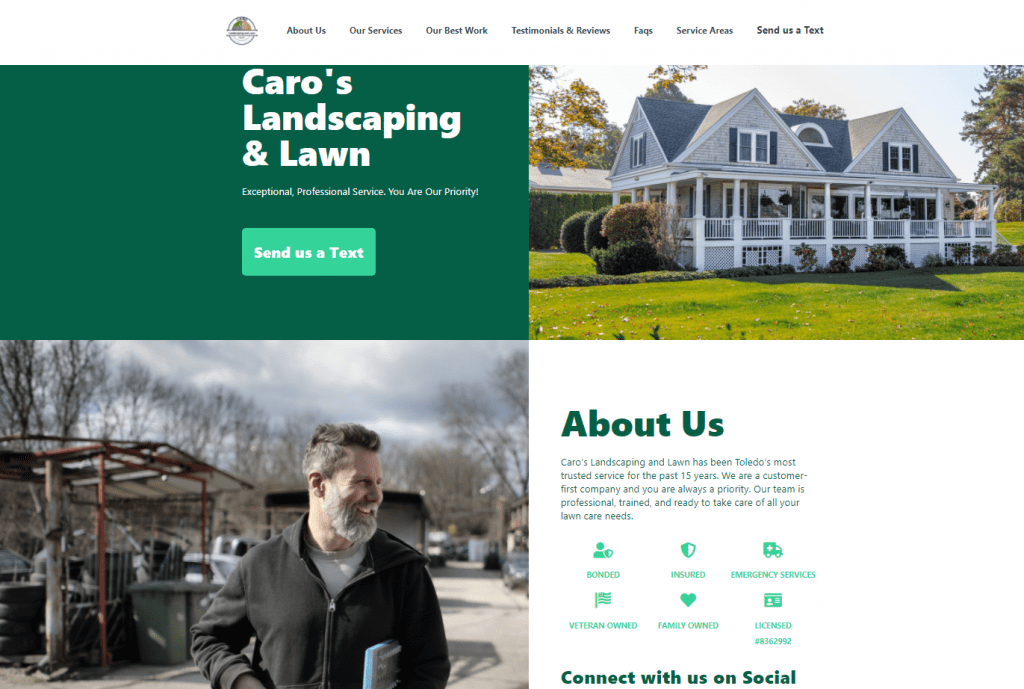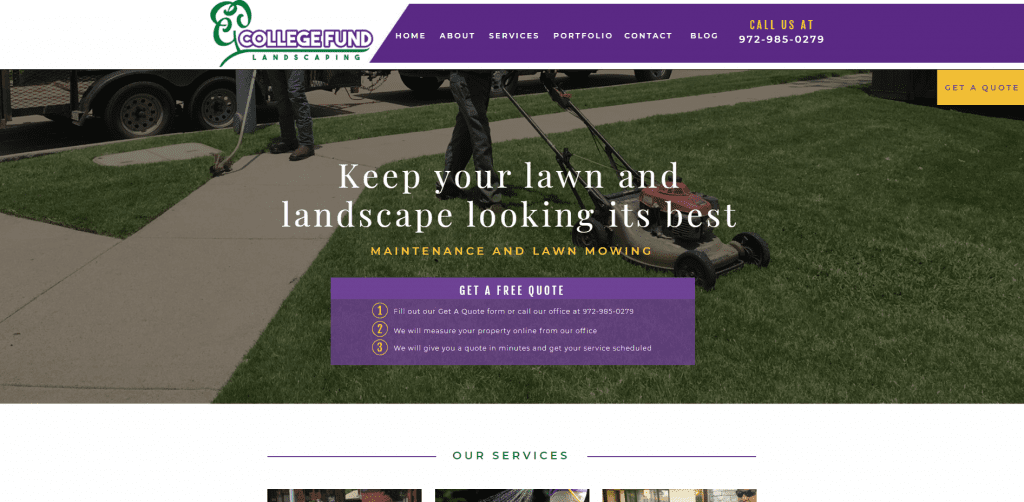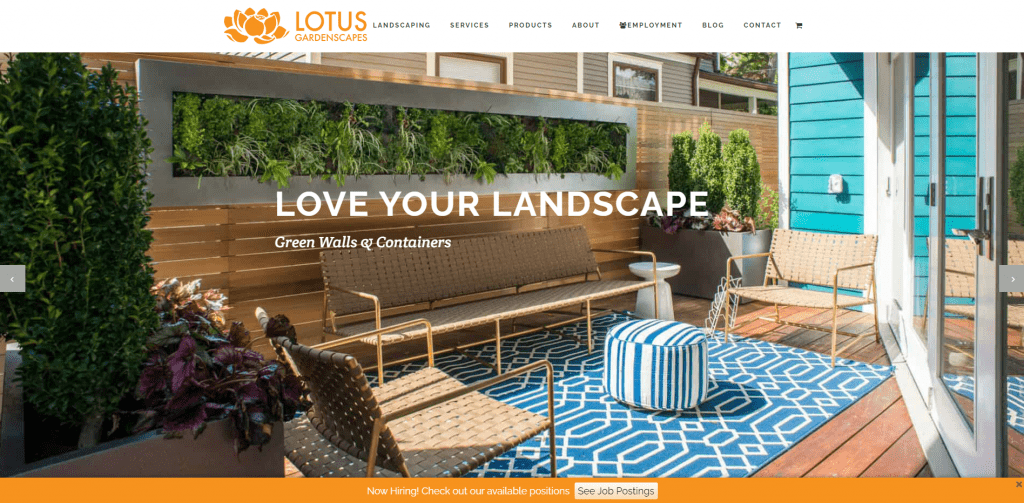
While most customers come from referrals and word of mouth, people who are looking for a lawn care or a landscape company without a suggestion from a friend or family member are going to be searching online. Even if a potential client has received a referral, some still like to check out the business’s website.
“Many customers today will evaluate businesses not just on word of mouth,” says Nick Ornitz, CEO and co-founder of ProPhone. “Some still get all their referrals from friends and family, but there is a large percentage of customers that are searching online, and the easiest first way to evaluate a business is when you click their page how modern does the site look and what are the reviews on their site.”
If you’re like most landscape companies, you probably have a website for this specific purpose, but does it just check the box of having a business website or does it truly represent your brand well and answer visitors’ questions about what you do and where you do it?
Why Up-To-Date Websites Matter

First impressions are important and websites are often a gateway on how your company presents itself to potential customers and job applicants.
“When you have an up-to-date website that is current, it shows really nice photography and answers their questions right away and gives them the results that they’re looking for it makes it a lot easier to close that deal,” says Kelly Dowell, founder of Keldo Digital.
You might be under the impression that if your website isn’t ‘broke’ there’s no need to fix it.
“This is a very commonly misinterpreted phrase in the industry, as determining whether a website is broken can’t happen without knowing exactly what your landscape website is supposed to do,” says Adam Strimaitis, vice president of channel sales and partnerships for Webware.io. “Loosely translated, if your website is not getting your phone ringing, keeping it ringing, generating leads & referrals and ultimately revenue, then it is ‘broke’ and needs to be fixed.”
Dowell says landscape professionals need to view their websites as an investment and with the rate that technology changes, there is always room for improvement. It’s not about a site being ‘broke’ but being better. She stresses the importance of using high-res photography and videography on your website.
“That’s what’s really going to make you stand out in today’s day and age because of the way that modern templates are laid out,” she says. “They are very image-driven so if you have a low-resolution file as your banner image that’s not going to show well.”
If you already have enough business, having an up-to-date website can help attract larger, more professional clients that like to look through a website and see how modern the business is. Also, it’s hard to predict the future and while you might have enough clients today you might not have enough tomorrow.
“There’s always things you can keep improving on a website, and it might be dependent on where the business is,” Ornitz says. “Again, if you are overwhelmed with the number of customers you have, your focus might be on providing the best service to those customers versus time invested in revamping your site.”
Having a website that helps build your presence gives you something to fall back on when you do need to attract more clients. You can also showcase your services and avoid getting calls about services you don’t do in areas you don’t serve.
“Up-to-date websites are not only vital to attracting new clients, but they also play a pivotal role in having your website found online,” Strimaitis says. “Google’s selection algorithm on which websites appear on Page One of each relevant search is not arbitrary – it is largely predicated on a fresh look, new content, and contextual changes to reflect the marketplace.”
Dowell, Ornitz and Strimaitis all agree that if your site looks like belongs in the 90s, it’s going to be a turnoff for potential customers, and you could be losing out on business.
“Much like a professionally landscaped property, aesthetic, modern, eye-catching presentation is the big draw that leaves people wanting to know more,” Strimaitis says. “Unfortunately, landscape companies who have outdated websites never truly know how many customers they have lost – simply because they look…and don’t call.”
Dowell advises looking at your site’s bounce rate to determine if visitors are staying on your site and looking around or leaving right after seeing the homepage.
“Because a lot of landscapers have modern websites, if you haven’t updated yours in many years you’re competing against someone that has a more modern site and what that can lead to is customers thinking either the company isn’t high enough quality or maybe the tools and the resources they’re using are going to resemble what’s on their site and be outdated,” Ornitz says.
How Often Should You Update?
So, you might be wondering how often you should be updating your website so it stays looking current. Here the advice varies among the pros with Ornitz saying a good rule of thumb is at least monthly and Strimaitis says owners should have their ‘head on a swivel’ when it comes to their website and ensure it’s doing what it’s supposed to do.

For a full evaluation, Strimaitis suggests conducting one at least once per quarter. Dowell advises at least yearly going over your website with a fine-tooth comb to make sure that everything is current and speaking the right language.
Updates to your site can include adding new project photos, recent customer reviews, and promotions for seasonal services. Making these small changes can help Google know that your site is active.
“When it comes to your company website, change is essentially synonymous with progress,” Strimaitis says. “Content changes are the key. Keeping information up to date, highlighting services and promotions, and even having a “Spotlight” segment each month to show your audience the great work you have done, all go a long, long way.”
Ornitz says one option is to A/B test different elements on your webpage such as your call to action buttons’ wording: ‘Call me,’ ‘Contact me,’ ‘Book a service,’ etc. As for how long to run an A/B test, it depends on the amount of traffic you receive regularly. If you have hundreds of visitors, you can test at a faster cadence.
Dealing with Low Traffic Pages
If you’ve noticed on your Google Analytics that certain pages are performing poorly, this isn’t a sign to delete that page. Rather evaluate why exactly they aren’t getting a lot of traffic. Is the page hard to navigate to? Is this information on the page valuable to the customer?

“Both of those cases can be improved, rather than just eliminating the page outright,” Ornitz says. “So one, you can look at where’s that page being linked to. Do you need to change how the page is structured so folks can find it, or two, if the content doesn’t seem very valuable if people aren’t clicking to it, ask yourself why is that? Are you just not putting enough detail into that page or are customers not really concerned about what’s on there?”
Dowell says when she goes over Google Analytics with her customers, the page they find people don’t go to is typically a devoted page for testimonials. She says she’s seen these types of pages go away over the years because visitors know if you’re populating the reviews, you aren’t going to include a negative one. Dowell says she likes the service GatherUp because it will post real reviews in real-time.
“Each landing page is engaged based on search quantity, so a landscape company needs to ensure that along with their website (which needs to be SEO optimized and fully functional), that they have some sort of digital marketing presence to drive traffic to each page,” Strimaitis says.
If visitors aren’t going to a page and it’s in the navigation bar, chances are you can use that space for something else.
Investing in a Revamp
After evaluating your website and realizing it needs more than a few tweaks, you might be hesitant to update or upgrade your company website out of concern your existing site will be stuck with the dreaded “website under construction” text for weeks or months. However, this isn’t an issue as you can keep your existing site up and running while the updates are being made or while the new site is being built.

You also might be reluctant to go through with a revamp due to the time and money that needs to be invested. However, the spectrum of how much it could cost depends on the route you go.
On the cheaper end, you can go with build-it-yourself sites like Wix or Squarespace costing $20 to $30 a month. ProPhone charges $30 a month, including website design and monthly updates. Landscape professionals can access the site to make changes themselves or ProPhone can make tweaks for them.
“Most folks think you need to spend thousands of dollars a month or more on a website and there are alternatives to doing that,” Ornitz says. “So that’s what we’re trying to help with.”
Hiring a freelancer can cost more than $100 an hour to get a modern website. Dowell advises when working with a freelance designer that they make your site accessible enough that you can make small changes on the backend. Ornitz cautions owners should be wary of website designers promising they’ll get you on page one of the Google results in a few days. While you can improve your site rankings over time, avoid people who promise too much with too little work.
On the high-end, there are agencies and marketing companies that can cost hundreds of dollars a month. If you can afford a “do-it-all-for-you” option, this could range anywhere from $5,000 to $20,000. Webware.io can take care of everything from $997 to $1,997.
“You shouldn’t have to invest any time except for providing content, images, and for approving the work,” Strimaitis says. “Anything more than that is taking time away from you doing what you do best.”
This article was published in the September/October issue of the magazine. To read more stories from The Landscape Professional magazine, click here to subscribe to the digital edition.

